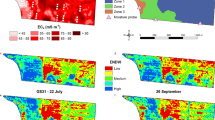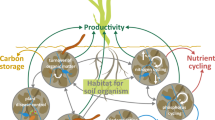Abstract
Aims
Soil salinity can cause salt plant stress by reducing plant transpiration and yield due to very low osmotic potentials in the soil. For predicting this reduction, we present a simulation study to (i) identify a suitable functional form of the transpiration reduction function and (ii) to explain the different shapes of empirically observed reduction functions.
Methods
We used high resolution simulations with a model that couples 3D water flow and salt transport in the soil towards individual roots with flow in the root system.
Results
The simulations demonstrated that the local total water potential at the soil-root interface, i.e. the sum of the matric and osmotic potentials, is for a given root system, uniquely and piecewise linearly related to the transpiration rate. Using bulk total water potentials, i.e. spatially and temporally averaged potentials in the soil around roots, sigmoid relations were obtained. Unlike for the local potentials, the sigmoid relations were non-unique functions of the total bulk potential but depended on the contribution of the bulk osmotic potential.
Conclusions
To a large extent, Transpiration reduction is controlled by water potentials at the soil-root interface. Since spatial gradients in water potentials around roots are different for osmotic and matric potentials, depending on the root density and on soil hydraulic properties, transpiration reduction functions in terms of bulk water potentials cannot be transferred to other conditions, i.e. soil type, salt content, root density, beyond the conditions for which they were derived. Such a transfer could be achieved by downscaling to the soil-root interface using simulations with a high resolution process model.










Similar content being viewed by others
References
Bechtold M, Vanderborght J, Ippisch O, Vereecken H (2011) Efficient random walk particle tracking algorithm for advective-dispersive transport in media with discontinuous dispersion coefficients and water contents. Water Resour Res 47, W10526
Bhantana P. and Lazarovitch N. (2010) Evapotranspiration, crop coefficient and growth of two young pomegranate (Punica granatum L.) varieties under salt stress. Agric. Water Manage. doi:10.1016/j.agwat.2009.12.016
Cardon G, Letey J (1992) Plant water uptake terms evaluated for soil water and solute movement models. Soil Sci Soc Am J 32:1876–1880
Couvreur V, Vanderborght J, Javaux M (2012) A simple three-dimensional macroscopic root water uptake model based on the hydraulic architecture approach. Hydrol Earth Syst Sci 16:2957–2971
de Jong van Lier QD, van Dam JC, Metselaar K, de Jong R, Duijnisveld WHM (2008) Macroscopic root water uptake distribution using a matric flux potential approach. Vadose Zone J 7:1065–1078. doi:10.2136/vzj2007.0083
De Wit C (1958) Transpiration and crop yields. Versl Landbouwk Onderz 64. 6. Universtity Wageningen.
Doussan C, Pagès L, Vercambre G (1998) Modelling of the hydraulic architecture of root systems: an integrated approach to water absorption—model description. Ann Bot 81:213–223
Doussan C, Pierret A, Garrigues E, Pagès L (2006) Water uptake by plant roots: II—modelling of water transfer in the soil root-system with explicit account of flow within the root system—comparison with experiments. Plant Soil 283:99–117
Dirksen C, Kool JB, Koorevaar P, van Genuchten MT (1993) HYSWASOR- simulation model of hysteretic water and solute transport in the root zone. In: Water flow and solute transport in soils. Springer Berlin, Heidelberg, pp 99--122. doi:10.1007/978-3-642-77947-3_8
Dudley LM, Shani U (2003) Modeling plant response to drought and salt stress reformulation of the root-sink term. Vadose Zone J 2:751–758
Feddes R, Raats P (2004) Parameterizing the soil-water-plant root system. In: Feddes R, de Rooij G, van Dam J (eds) Unsaturated-zone modeling: progress, challenges and applications. UR Frontis Series, Wageningen, pp 95–141
Feddes R, Kowalik P, Kolinska-Malinka K, Zaradny H (1976) Simulation of field water uptake by plants using a soil water dependent root extraction function. J Hydrol 31:13–26
Feddes R, Kowalik P, Zaradny H (1978) Simulation of field water use and crop yield. 188
Gardner W (1960) Dynamic aspects of water availability to plants. Soil Sci 89(2):63–73
Groenveld T, Ben-Gal A, Yermiyahu U, Lazarovitch N (2013) Weather determined relative sensitivity of plants to salinity: quantification and simulation. Vadose Zone J. doi:10.2136/vzj2012.0180
Hainsworth J, Aylmore L (1986) Water extraction by single plant roots. Soil Sci Soc Am J 50:841–848
Hamza M, Aylmore L (1992) Soil solute concentration and water uptake by single lupin and radish plant roots. Plant Soil 145:187–196
Homaee M, Dirksen C, Feddes RA (2002a) Simulation of root water uptake: I. Non-uniform transient salinity using different macroscopic reduction functions. Agric Water Manag 57:89–109
Homaee M, Feddes RA, Dirksen C (2002b) A macroscopic water extraction model for nonuniform transient salinity and water stress. Soil Sci Soc Am J 66:1764–1772
Homaee M, Feddes R, Dirksen C (2002c) Simulation of root water uptake: III. Non-uniform transient combined salinity and water stress. Agric Water Manag 57:127–144
Hopmans J, Bristow K (2002) Current capabilities and future needs of root water and nutrient uptake modeling. Adv Agron 77:104–175
Jarvis NJ (2011) Simple physics-based models of compensatory plant water uptake: concepts and eco-hydrological consequences. Hydrol Earth Syst Sci 15:3431–3446
Javaux M, Schröder T, Vanderborght J, Vereecken H (2008) Use of a three-dimensional detailed modeling approach for predicting root water uptake. Vadose Zone J 7(3):1079–1088
Knipfer T, Fricke W (2010) Root pressure and a solute reflection coefficient close to unity exclude a purely apoplastic pathway of radial water transport in barley (Hordeum vulgare). New Phytol 187:159–170
Kroes J, van Dam J, Groenendijk P, Hendriks R, Jacobs C (2008) SWAP version 3.2. In: Theory description and user manual. Wageningen, The Netherlands, p 262
Maas E, Hoffman G (1977) Crop salt tolerance-current assessment. J Irrig Drain Div 103:115–134
Metselaar K, de Jong van Lier Q (2007) The shape of the transpiration reduction function under plant water stress. Vadose Zone J 6:124–139. doi:10.2136/vzj2006.0086
Nassar IN, Horton R (1997) Heat, water, and solute transfer in unsaturated porous media: I—theory development and transport coefficient evaluation. Transp Porous Media 27:17–38
Nimah MN, Hanks RJ (1973) Model for estimating soil water, plant, and atmospheric interrelations: I. Description and sensitivity. Soil Science Society of America Journal pp 522–527
Pagès L, Vercambre G, Drouet J (2004) Root Typ: a generic model to depict and analyse the root system architecture. Plant Soil 258:103–119
Richards LA (1931) Capillary conduction of liquids through porous mediums. Physics 1(5):318
Schröder T, Javaux M, Vanderborght J, Körfgen B, Vereecken H (2008) Effect of focal soil hydraulic conductivity drop using a three-dimensional root\water uptake model. Vadose Zone J 7:1089–1098
Schröder N, Javaux M, Vanderborght J, Steffen B, Vereecken H (2012) Effect of root water and solute uptake on apparent soil dispersivity: a simulation study. Vadose Zone J 11(3). doi: 10.2136/vzj2012.0009
Shani U, Ben-Gal A (2005) Long-term response of grapevines to salinity: osmotic effects and ion toxicity. Am J Enol Vitic 52:148–154
Siebert S, Burke J, Faures JM, Frenken K, Hoogeveen J, Döll P, Portmann FT (2010) Groundwater use for irrigation—a global inventory. Hydrol Earth Syst Sci 14(10):1863–1880
Simunek J, Sejna M, Saito H, Sakai M, van Genuchten MT (2013) The HYDRUS-1D software package for simulating the movement of water, heat, and multiple solutes in variably saturated media. HYDRUS Softw 3, Department of Environmental Sciences, University of California Riverside, Riverside, California, USA
Skaggs TH, van Genuchten MT, Shouse PJ, Poss JA (2006) Macroscopic approaches to root water uptake as a function of water and salinity stress. Agric Water Manag 86:140–149
Tardieu F (1996) Drought perception by plants. Do cells of droughted plants experience water stress? Plant Growth Regul 20:93–104. doi:10.1007/BF00024005
van Genuchten M (1980) A closed-form equation for predicting the hydraulic conductivity of unsaturated soils. Soil Sci Soc Am J 8:892–898
van Genuchten M (1987) A numerical model for water and solute movement in and below the root zone. United States Department of Agriculture Agricultural Research Service U.S. Salinity Laboratory
van Genuchten M, Hoffman G (1984) Analysis of crop salt tolerance data. In: Soil Salinity under Irrigation. Processen and Management. Springer Verlag, New York, pp 251–271
Van Genuchten M, Leij F, Yates S (1991) The RETC code for quantifying the hydraulic functions of unsaturated soils. Riverside, California: EPA Report 600/2-91/065, U.S. Salinity Laboratory, USDA, ARS.
Acknowledgments
This work was partly funded by the I-CORE Program of the Planning and Budgeting Committee and the Israel Science Foundation (Grant 152/11).
Author information
Authors and Affiliations
Corresponding author
Additional information
Responsible Editor: Rafael S. Oliveira.
Appendix: model description
Appendix: model description
The model R-SWMS simulates both, soil and root water flow. Soil water flow is defined by the Richards equation (Richards 1931)
where θ [L3 L−3] is the volumetric water content, t [T] is time, K [L T−1] is the hydraulic conductivity tensor, h [L] is the matric potential, S [T−1] is a sink term representing the root water uptake, and z [L] is the vertical coordinate positive upward. The model of (Doussan et al. 1998) is coupled to the soil water flow. This model calculates water flow inside the roots based on a root network architecture, which is described as a network of connected root nodes. The axial xylem flow J x [L3 T−1] in a root segment describes water flow within the root xylem by
where K x * [L T−1] is the xylem conductivity, A x [L2] is the xylem cross-sectional area, z [L] the vertical coordinate, l seg [L] the root segment length, and h xylem [L] the water pressure potential in the xylem.
The radial water flow Jr [L3 T−1] between the soil-root interface and the root xylem is defined by Doussan et al. (1998) and used in R-SWMS as
with the radial root conductance K r * [T−1], the root outer surface A r [L2] and the water potential at the soil–root interface H int [L] and in the xylem H xylem [L].
The calculations of soil and root water flow inside R-SWMS are coupled as described in Javaux et al. (2008) via the water sink term S in the Richards equation and defined for one soil voxel by
where Jk is the radial fluxes into the root segment k, located in a soil voxel j. Here, V j is the voxel volume, and n k is the number of root segments within voxel j.
The solute movement inside the soil is described by the convection–dispersion equation (CDE)
where c [M L−3] is the solute concentration, u [L T−1] is the pore water velocity, S ′ [T−1] is the solute sink term and D [L2 T−1] is the dispersion coefficient tensor, defined as
where \( \left\Vert u\right\Vert =\sqrt{u{u}^T} \) is the Euclidean norm of the pore water velocity vector, αL and αT are the longitudinal and transverse dispersivities, respectively, D W [L2 T−1] is the molecular diffusion coefficient and τ [−] is the tortuosity factor.
The CDE is solved by the model PARTRACE (Bechtold et al. 2011; Schröder et al. 2012). PARTRACE solves a random walk particle tracking algorithm, where an equivalent stochastic differential definition of the CDE is used, which contains the velocity provided by R-SWMS and a random displacement which accounts for the dispersion. A large number of solute particles represent the solute mass and are moved through the system according to this equation.
With an interface between R-SWMS and PARTRACE, velocity and water sink term profiles are updated in every time step and provided to the solute transport code. In addition, after the concentration profile is calculated by PARTRACE, a feedback coupling supply the concentration values, which are transformed to osmotic potentials, to the soil and root water module of the model (R-SWMS).
Rights and permissions
About this article
Cite this article
Schröder, N., Lazarovitch, N., Vanderborght, J. et al. Linking transpiration reduction to rhizosphere salinity using a 3D coupled soil-plant model. Plant Soil 377, 277–293 (2014). https://doi.org/10.1007/s11104-013-1990-8
Received:
Accepted:
Published:
Issue Date:
DOI: https://doi.org/10.1007/s11104-013-1990-8




